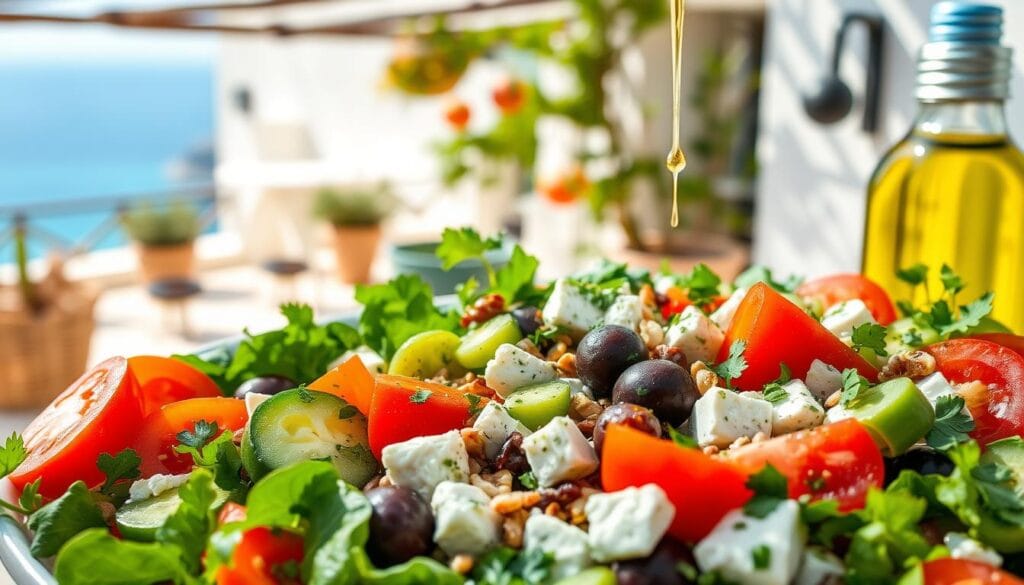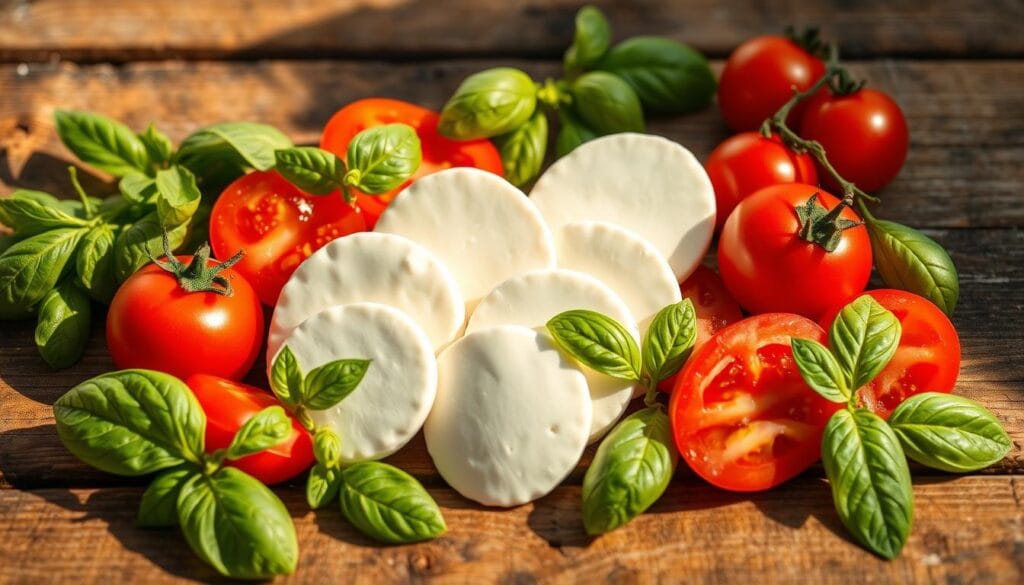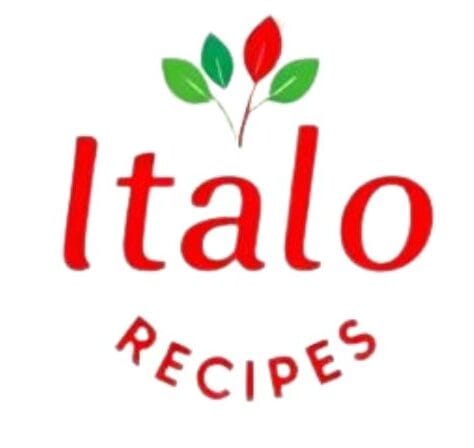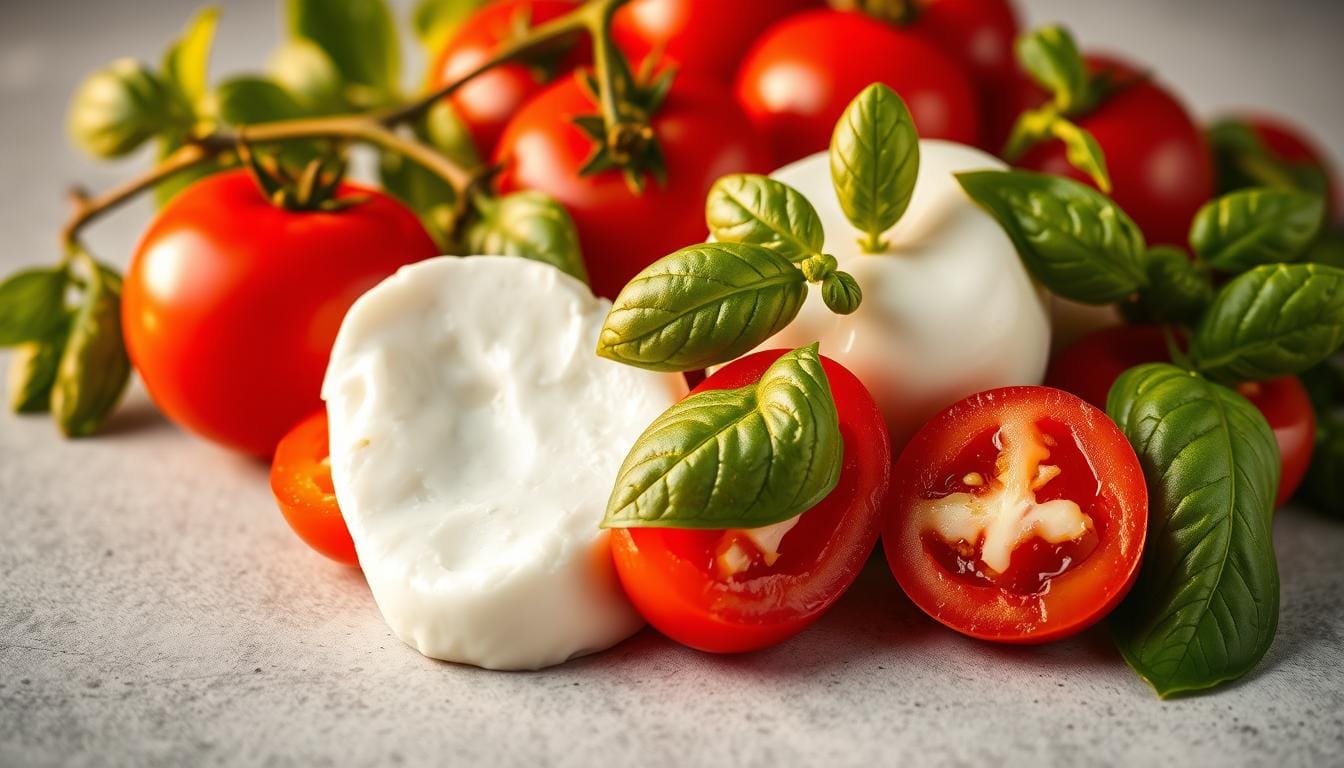The Irresistible Charm of Salade Caprese 25: An Italian Classic
Imagine biting into a slice of ripe, sun-ripened tomato. Its juice mixes with creamy mozzarella and olive oil. That’s the magic of insalata caprese, turning simple ingredients into a flavor symphony. If you’ve ever tasted an Italian salad, you know why these recipes are loved worldwide.
Picture a vibrant plate with red, white, and green layers, like Italy’s flag. Yet, it tastes like pure summer. That’s the power of salade caprese. It’s a dish so simple yet profound, loved by all.
Table of Contents
Key Takeaways
- Salade Caprese blends Italy’s iconic ingredients into a dish celebrated worldwide.
- Its 50+ Italian salad variations prove creativity thrives in simplicity.
- Quick recipes like 10-minute quinoa caprese fit modern, health-conscious lifestyles.
- Seasonal ingredients like summer tomatoes and winter-friendly options show adaptability.
- It’s a gateway to Mediterranean flavors, from Keto-friendly options to TikTok trends.
This article explores how a simple salad became a symbol of Italy’s culinary artistry. Discover why insalata caprese isn’t just a meal—it’s a taste of Italy’s timeless elegance.
What Makes Salade Caprese a Mediterranean Masterpiece
Salade Caprese is more than a salad. It’s a celebration of Mediterranean and Italian cooking. It turns simple ingredients into something amazing.
The Perfect Balance of Flavors and Textures
Imagine juicy tomatoes and soft mozzarella coming together. Add fresh basil, and you get a mix of sweet, savory, and herb flavors. Each part enhances the others, showing that simple can be complex.
A Colorful Representation of the Italian Flag
Red tomatoes, white mozzarella, and green basil are more than ingredients. They’re a tribute to Italy’s flag. Every plate becomes a beautiful, patriotic dish, blending pride with art.
Simplicity as the Ultimate Sophistication
Salade Caprese has only three main parts. It shows Italy’s love for letting ingredients speak for themselves. A little olive oil and salt bring out their true flavors.
The Rich History Behind Insalata Caprese
Insalata caprese, also known as salade caprese, has its roots on the island of Capri in the early 20th century. This dish celebrates local Campania ingredients, showing Italy’s culinary pride. It went from a regional favorite to a global hit, linked to art, politics, and tourism.
In 1922, the Futurist movement’s conference at Capri’s Grand Hotel Quisisana was key. Chefs made a new dish with fresh tomatoes, mozzarella, and basil, rejecting traditional pasta. It’s said to have been made for poet Filippo Tommaso Marinetti, a Futurist leader who loved new foods. By the 1950s, it was known as Capri’s symbol, enjoyed by stars like Grace Kelly and Sophia Loren.
- 1920s: Born in Capri, inspired by national pride and avant-garde culinary trends
- 1952: King Farouk of Egypt reportedly ate it daily as a sandwich during his exile
- 1950s: Popularized by jet-setters, elevating it from local fare to global delicacy
- Today: A timeless classic balancing tradition and adaptability
The dish’s colors—red tomatoes, white mozzarella, green basil—echo Italy’s flag, showing its patriotic side. It has grown from a simple island dish to a worldwide favorite. Enjoyed as an appetizer or light meal, insalata caprese shows Italy’s belief: less is more.
Essential Ingredients for an Authentic Salade Caprese
Making a real Salade Caprese needs the right ingredients. Each part, from tomatoes to basil, must be picked carefully. The best salade de tomates mozzarella and salade de basilic frais come from this attention to detail. Let’s see how to pick each part perfectly.
Selecting the Perfect Tomatoes
Look for tomatoes at their best. Heirloom types like Brandywine or Cherokee Purple have great flavors. They should be firm and without soft spots. Keep them at room temperature to keep their sweetness.
Don’t use winter tomatoes from the store. They don’t have the right acidity for the salade de tomates mozzarella.
Choosing the Right Mozzarella
- Go for fresh mozzarella in brine, not vacuum-sealed. Buffalo milk is traditional, but good fior di latte (cow’s milk) works too.
- It should feel soft and springy. Stay away from too moist or rubbery mozzarella.
Fresh Basil: The Aromatic Crown
Genovese basil is key for its peppery smell. Keep the stems in water to stop them from turning brown. This is crucial for a fresh salade de basilic frais. Always tear the leaves gently to keep their oils.
Extra Virgin Olive Oil: The Liquid Gold
Use Italian EVOO with a grassy taste. Brands like Castello di Cardinale or Carapelli are authentic. A little of this “liquid gold” makes every bite better without taking over the dish.
Step-by-Step Guide to Creating the Perfect Salade Caprese Simple
Turn fresh ingredients into a masterpiece with this easy guide. Learn the techniques that make authentic salade caprese simple. Make sure every part of the salad shines.
Preparation Techniques
Begin by cutting tomatoes into ½-inch rounds. Thin slices might wilt, while thick ones lose moisture. Drain mozzarella balls well with a clean towel to remove excess water.
Tear basil leaves by hand to avoid bruising. Keep tomatoes and basil in the fridge until you’re ready to put the salad together.
Assembly Methods
- Circular Presentation: Place tomato, mozzarella, and basil slices in a circle on a platter.
- Stacked Style: Stack the ingredients vertically in a glass bowl for a modern look.
- Rustic Plating: Spread the ingredients loosely on a wooden board for a casual yet elegant feel.
Seasoning Tips
Season tomatoes with salt 5–10 minutes before serving. This helps draw out juices without over-salting. Use freshly ground pepper for a better aroma.
Drizzle olive oil from 6 inches above to coat evenly. Add a dash of balsamic glaze (2 tbsp vinegar + 1 tsp sugar reduced in a pan) for depth without losing freshness.
Pair with a light vinaigrette. Use 3 tbsp olive oil, 1 tbsp red wine vinegar, and minced garlic for extra taste. Serve right away to keep the salad crisp. It’s best enjoyed within 30 minutes of making.
Modern Variations of the Classic Salade Caprese
Salade Caprese classique is a timeless favorite. But, chefs and home cooks are making new versions. They keep the dish simple while adding their own twist. Here’s how to innovate while staying true to the fresh ingredients.
- Caprese Skewers: Thread cherry tomatoes, basil, and mozzarella cubes on rosemary sprigs for a rustic appetizer.
- Pasta Salade Caprese: Toss bowtie pasta with tomatoes, mozzarella, and a balsamic glaze for a hearty meal.
- Burrata Salad: Swap mozzarella for creamy burrata and add heirloom tomatoes for a vibrant twist.
- Caprese Panini: Layer ingredients between grilled sourdough with pesto for a handheld treat.
Try new textures and flavors while keeping basil, tomatoes, and cheese as the base. Add avocado for creaminess or use peaches in summer. Remember, drizzle extra virgin olive oil and a pinch of salt to bring out the freshness. Even Caprese-stuffed chicken or grilled pork chops show the salad’s versatility.
Always keep the classic’s balance in mind. Whether you make Caprese risotto or pastry bites, stay true to the original. Your taste buds—and guests—will love the creativity.
The Nutritional Benefits of This Salade Méditerranéenne
Enjoying a Salade Méditerranéenne like the Salade Caprese is good for more than just your taste buds. It’s packed with nutrients. With 255 calories per serving, it fits the Mediterranean diet, known for heart health and long life. Let’s see how each part of the salad boosts your health.

Protein Content from Fresh Mozzarella
Fresh mozzarella has 13g of protein per serving. It has all the amino acids your muscles and tissues need. It also has calcium for strong bones, but be careful not to eat too much to avoid too much sodium.
It’s better than processed cheeses because of its protein-to-fat ratio. This makes it a great choice for a balanced diet.
Antioxidant Properties of Tomatoes
Tomatoes are full of lycopene, an antioxidant that helps prevent heart disease and cancer. They also have vitamin C to boost your immune system. Even if they’re raw, they still have lots of nutrients.
Studies show that cooking tomatoes can make their lycopene easier to absorb. But the salad’s fresh tomatoes still have plenty of benefits.
Healthy Fats from Olive Oil
Adding extra-virgin olive oil to your salad gives you monounsaturated fats. These fats can lower LDL cholesterol. The polyphenols in olive oil also fight inflammation, which is key to the Mediterranean diet’s health benefits.
Enjoy the flavor of olive oil, but do it in moderation. This way, you get the health benefits without too many calories.
Perfect Wine Pairings for Your Salade de Tomates Mozzarella
A good wine can make your salade italienne even better. Choose crisp whites, refreshing rosés, or Italian wines. They bring out the salad’s freshness without overwhelming it.
When picking wine, think about acidity and lightness. Wines that match the tomato’s brightness, mozzarella’s creaminess, and basil’s taste are best. This way, every sip will make your meal better.
White Wine Options
| Wine | Varietal | Why It Works |
|---|---|---|
| Pinot Grigio | Northern Italian | Crisp acidity cuts through mozzarella’s richness. Try Veneto or Alto Adige bottlings. |
| Vermentino | Sardinian or Tuscan | Citrusy notes mirror tomato sweetness. Great with basil’s peppery tones. |
| Sauvignon Blanc | Friulian | Herbal undertones echo the salad’s fresh basil. Look for unoaked styles. |
Rosé Recommendations
Light rosés balance the salad’s saltiness and freshness:
- Provençal Rosé: Mineral-driven styles from France’s south pair with tomato acidity.
- Italian Rosato: Bright Sicilian or Apulian wines match the salad’s rustic origins.
- Off-dry German Riesling: A surprising option for those who prefer fruit-forward pours.
Italian Wine Selections
Regional Italian wines tie the dish to its roots. Consider these options:
- Falanghina (Campania): Almondty finish contrasts mozzarella’s mild flavor.
- Verdicchio (Marche): Almond notes and salinity mirror tomatoes’ juiciness.
- Bardolino (Veneto): Chilled light reds add warmth without heaviness.
Try these wines to find your favorite. Let the wine’s acidity or minerality guide you. Your salade italienne will thank you with every sip.
Common Mistakes to Avoid When Preparing Salade Caprese Classique
Even with top-notch ingredients, simple mistakes can mess up your insalata caprese. Here’s how to steer clear of them:
- Using subpar ingredients: Choose ripe heirloom tomatoes, fresh buffalo mozzarella (not pre-sliced), and basil that’s been picked just before you serve. For salade caprese classique, fresh tomatoes are better than San Marzano for their flavor.
- Over-handling: Cut tomatoes and cheese right before you serve to keep them from getting soggy. Use a serrated knife for clean cuts (about ¼-inch thick). Never put them in the fridge—cold makes them lose their sweetness.
- Imbalanced seasoning: Salt tomatoes 20–30 minutes before to get rid of extra moisture. Use 6 tbsp extra virgin olive oil and 2 tbsp DOP balsamic vinegar in a 3:1 ratio. Don’t add too much vinegar.

Pro tips: Serve it right away (within 15 minutes of making it) to keep the texture good. Don’t use dried herbs—fresh basil is a must. If you can’t find buffalo mozzarella, burrata is a good substitute. Pair it with crusty bread to soak up the juices.
By following these tips, your insalata caprese will truly show off its Italian heritage. Remember, the key is in the quality of your ingredients and the timing. Don’t take shortcuts—your taste buds (and your guests) will thank you.
Seasonal Considerations for Your Salade de Basilic Frais
In the kitchen, timing is everything. Knowing when to use fresh ingredients can make a salade caprese simple truly special. Let the seasons guide your choices for the best taste and texture.
Summer: The Prime Caprese Season
Summer’s warmth makes tomatoes sweeter, and salade de basilic frais more fragrant. Mozzarella di bufala stays cool and creamy, perfect with the warm veggies. Enjoy it chilled at a picnic or as a starter at a barbecue. Its colors match summer’s vibrant hues.
“A great Caprese needs no kitchen tricks—just ripe ingredients.” – Chef Giada De Laurentiis
Making Adjustments for Off-Season Preparation
Winter doesn’t mean you have to skip this dish. Here are some tips to adapt:
- Use greenhouse-grown tomatoes or vine-ripened imports for firm texture
- Substitute fresh basil with a sprinkle of dried basil or a spoonful of pesto
- Rossini tomatoes or sun-dried tomato slices add depth when fresh options fade
- Pair with citrus segments or arugula for brightness in colder months
Being creative all year keeps salade caprese simple on your table. Choose quality ingredients even when they’re not in season. Your taste buds will appreciate it.
Conclusion: Embracing the Timeless Appeal of Salade Caprese
Salade Caprese stands as a symbol of Italian cuisine’s essence. It combines simplicity with top-notch ingredients. This dish uses fresh tomatoes, creamy mozzarella, and fragrant basil to create a perfect blend of tastes.
Its bright colors and easy preparation reflect the Mediterranean’s focus on quality over complexity. This approach makes it a favorite among food lovers.
Heirloom tomatoes and olive oil make it not only delicious but also healthy. Restaurants see 60% of guests choose it, loving its lightness and refreshing taste. Its red, white, and green colors add 25% to meal satisfaction and appeal.
This salad is versatile, pairing well with bread or meatballs. Its recipe allows for personal touches while staying true to its roots. By using seasonal ingredients and careful assembly, you create a dish that’s always fresh and exciting.
Salade Caprese is more than a meal; it’s a celebration of freshness. It continues to inspire both home cooks and chefs, showing that timeless dishes can evolve while staying authentic.
FAQ
What is Salade Caprese?
How do I select the best tomatoes for my Caprese salad?
What type of mozzarella is best for Salade Caprese?
Why is fresh basil important in a Caprese salad?
How should I prepare my Salade Caprese for the best presentation?
Can I make variations of the traditional Caprese salad?
What are the health benefits of Salade Caprese?
What wines pair well with Salade Caprese?
What common mistakes should I avoid when making Caprese salad?
How does seasonality affect the quality of Salade Caprese?
Source Links
Une réponse à “The Irresistible Charm of Salade Caprese 25: An Italian Classic”
[…] The Irresistible Charm Of Salade Caprese 25: An Italian Classic […]


Laisser un commentaire